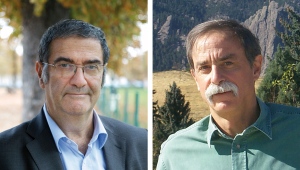
Serge Haroche (left) and David Wineland discovered ways to probe the quantum states of particles.
C. LEBEDINSKY/CNRS PHOTOTHÈQUE; NIST
As delicate as gossamer, the quantum properties of particles are apt to disappear as soon as physicists try to measure them. But it is possible to build a window on the quantum world to reveal these properties: and for that, Serge Haroche of the College of France, Paris, and David Wineland of the National Institute of Standards and Technology in Boulder, Colorado, have been awarded an equal share of this year’s Nobel Prize in Physics.
Haroche uses atoms as a sensitive probe of light particles trapped in a cavity, whereas Wineland takes the opposite approach, using light to measure the quantum states of atoms. Both techniques have helped to investigate the fundamentals of quantum mechanics, and they are helping to develop new technologies such as quantum computers or atomic clocks of dizzying precision. News of the award came as a shock to Haroche: “I recognized the Swedish phone code. I had to sit down,” he said at a press conference shortly after the announcement.
In the quantum world, particles of light and matter obey strange rules. One particle can occupy several mutually exclusive states simultaneously, for example, and groups of particles can be mysteriously connected through a process known as entanglement. But these quantum properties are hard to see: particles will show their quantum nature only in isolation, and even the slightest bump from the outside world will destroy their quantum states. That makes experiments extremely tricky, because the act of measuring itself is enough to upset the system. The techniques developed by Wineland and Haroche gave physicists a way to probe these states without destroying them.
Haroche’s experiments bounce microwave photons between a pair of superconducting mirrors, and send a stream of rubidium atoms through the fog of photons. By measuring the spins of the atoms as they enter and exit the mirrored cavity, he is able to indirectly probe the quantum properties of the microwave photons inside. Progressive measurements have, for example, allowed his team to observe a photon’s quantum wavefunction — which simultaneously describes all of its possible quantum states — and then monitor its collapse to a single, well-defined state1.
Wineland’s group traps beryllium ions in electric fields, and cools them with a laser that excites the ion’s electrons. This sucks vibrational energy from the system, lowering the temperature2. Researchers can then use lasers to alter vibrations between the ions, allowing them to control the quantum interactions in the system3. The work is already being used to build atomic clocks with unprecedented accuracy, says Immanuel Bloch, a physicist at the Max Planck Institute for Quantum Optics in Garching, Germany. Further down the line, these techniques could be used in a quantum computer — a device that can perform calculations using the probabilistic rules of quantum mechanics.
The award is “a great choice of two people who have really contributed to the foundations of quantum physics”, Bloch says. He notes that this is just the latest in a run of Nobel prizes for quantum optics. Bloch thinks that this is down to the myriad techniques, such as those of Wineland and Haroche, that are allowing researchers to isolate, study and manipulate increasingly complex quantum systems. “I think we’ve really seen atomic physics revolutionized,” he says.
